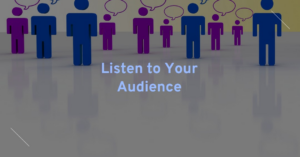Introduction:
In the dynamic world of social media, understanding your audience is essential for creating compelling content, fostering meaningful engagement, and building lasting relationships with your followers. Social media listening, also known as social media monitoring, involves actively monitoring and analyzing conversations, mentions, and trends across social media platforms to gain valuable insights into your audience’s preferences, interests, and behaviors. In this guide, we’ll explore the importance of social media listening and how it can help you gain a deeper understanding of your audience to inform your marketing strategies and drive business success.

1. Capturing Real-Time Insights:
Social media listening allows you to capture real-time insights into what your audience is saying, feeling, and experiencing. By monitoring conversations, comments, and mentions related to your brand, industry, or competitors, you can gain valuable insights into emerging trends, sentiment shifts, and consumer preferences as they happen. Real-time insights enable you to stay ahead of the curve, identify opportunities, and respond promptly to customer feedback or issues, strengthening your brand’s reputation and relevance in the eyes of your audience.
2. Identifying Audience Sentiment:
Social media listening enables you to gauge the sentiment of your audience towards your brand, products, or industry. By analyzing the tone, language, and context of social media conversations, you can identify patterns and trends in sentiment—whether positive, negative, or neutral—and understand the underlying reasons behind them. This insight allows you to tailor your messaging, content, and marketing efforts to better resonate with your audience’s sentiment, fostering positive relationships and mitigating potential risks or issues before they escalate.
3. Discovering Audience Preferences and Interests:
Social media listening provides valuable insights into your audience’s preferences, interests, and behaviors. By analyzing the topics, hashtags, and content types that resonate most with your audience, you can uncover their preferences and interests and tailor your content and marketing strategies accordingly. Identify common themes, trends, or pain points in social media conversations, and use this knowledge to create relevant, timely, and engaging content that addresses your audience’s needs and interests, driving higher engagement and loyalty.
4. Monitoring Competitor Activity:
Social media listening allows you to monitor competitor activity and benchmark your performance against industry peers. By tracking mentions, conversations, and engagement metrics related to your competitors, you can gain valuable insights into their strategies, strengths, and weaknesses. Identify areas where your competitors excel or fall short, and use this knowledge to refine your own strategies, differentiate your brand, and capitalize on opportunities to outperform your competitors in the eyes of your audience.
5. Improving Customer Service and Satisfaction:
Social media listening plays a crucial role in improving customer service and satisfaction by enabling you to respond promptly to customer inquiries, feedback, and complaints. By monitoring mentions and direct messages on social media, you can address customer concerns in real-time, provide timely assistance, and resolve issues before they escalate. Proactive engagement with your audience on social media demonstrates your commitment to customer satisfaction and builds trust and loyalty with your customers, enhancing their overall experience with your brand.
6. Informing Data-Driven Decision Making:
Social media listening provides valuable data and insights that can inform data-driven decision making across your organization. By analyzing social media metrics, trends, and audience feedback, you can identify opportunities for innovation, product development, marketing campaigns, and business growth. Use social media listening data to inform strategic decisions, allocate resources effectively, and measure the impact of your initiatives on audience engagement, sentiment, and brand perception, driving continuous improvement and success for your business.
Conclusion:
Social media listening is a powerful tool for understanding your audience, gaining valuable insights, and informing your marketing strategies and business decisions. By actively monitoring and analyzing conversations, mentions, and trends across social media platforms, you can capture real-time insights, identify audience sentiment, discover preferences and interests, monitor competitor activity, improve customer service, and inform data-driven decision making.
As you integrate social media listening into your marketing and business operations, remember to approach it with curiosity, empathy, and an open mind. Continuously listen to your audience, adapt to their evolving needs and preferences, and use the insights gained from social media listening to drive meaningful connections, foster engagement, and build lasting relationships with your audience, ultimately driving business success and growth.



